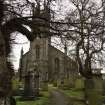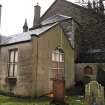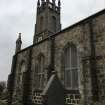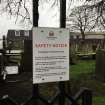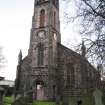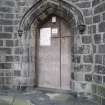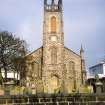Notice
Following a review of the Buildings at Risk Register we have paused the Register while we consider options for its future.
The website will remain accessible and searchable during this time, but it will not be updated and we’re not accepting nominations for additions to the Register. If you need to contact us about the BARR please email hmenquiries@hes.scot
Read the review report here and you can find out more about why we have paused the BARR on our news centre.
St Clement's (East) Church, St Clement Street, Aberdeen
Ordnance Survey licence number AC0000807262. All rights reserved. © Copyright and database right 2025. Public Sector Viewing Terms
Useful Links
- Canmore:
- ABERDEEN, SAINT CLEMENT STREET, EAST SAINT CLEMENT'S CHURCH, HALL AND CHURCHYARD
- Historic Scotland:
- HS Reference No 19954
General Details and Location
Category
AT RISK
Name of Building
St Clement's (East) Church
Other Name(s)
Address
St Clement Street, Aberdeen
Locality
Postcode
Planning Authority
Divisional Area
Reference No
2040
Listing Category
B
OS Grid Ref
NJ 95086 06240
Location Type
Urban
HS Reference No
19954
Description
3-bay symmetrical Gothic church, situated within graveyard with advanced central, pinnacled, crocketted and balustraded 4-stage entrance clock tower. Coursed and snecked granite rubble with smooth rubble dressings. Base course. Buttresses divide bays. Pinnacles to corners. Pointed segmental-arched openings. Central pointed-arched hoodmoulded entrance doorway (boarded up 2006). Louvred openings to belfry above. Later 19th century single storey hall attached to rear (E). Predominantly 4-pane fixed timber stained glass windows. Grey slates.
A good example of the work of local architect John Smith, East St Clement´s is a striking building with an associated churchyard with a good collection of monuments. The central pinnacled tower is a strong feature and acts as a local landmark. The church is situated close to the Harbour and the onetime fishing community of Footdee.
The church was built to replace an earlier chapel, dating from the 15th century which had been for the use of the local fishermen and their families who lived in the surrounding area. The church was designed by John Smith to be at the heart of an extensive newly designed neighbourhood and was originally meant to be at the North side of a square. The plans for the neighbourhood never materialised and the area around St Clement´s was gradually taken over by industry.
The graveyard provides an excellent historical record of the past local inhabitants, many of whom were involved in fishing or other maritime businesses.
John Smith (1781-1852), a native of Aberdeen, established himself in architectural practice in the city in 1804. He became the Master of Work in 1824 and designed many of Aberdeen´s public buildings, showing an expertise in working with granite. With Archibald Simpson, (1790-1847), he was one of the major architects involved in designing the expanding nineteenth century city of Aberdeen. His other works include the Aberdeen Arts Centre.
The church is currently disused (2006).
References from previous list description: Contracts, Aberdeen Journal Aug 15th 1827. NSA v12 p34. Hay Post-Ref Chs 241. Wilson, Delineation of Aberdeen p222. Chapman and Riley p147. (Historic Scotland)
A good example of the work of local architect John Smith, East St Clement´s is a striking building with an associated churchyard with a good collection of monuments. The central pinnacled tower is a strong feature and acts as a local landmark. The church is situated close to the Harbour and the onetime fishing community of Footdee.
The church was built to replace an earlier chapel, dating from the 15th century which had been for the use of the local fishermen and their families who lived in the surrounding area. The church was designed by John Smith to be at the heart of an extensive newly designed neighbourhood and was originally meant to be at the North side of a square. The plans for the neighbourhood never materialised and the area around St Clement´s was gradually taken over by industry.
The graveyard provides an excellent historical record of the past local inhabitants, many of whom were involved in fishing or other maritime businesses.
John Smith (1781-1852), a native of Aberdeen, established himself in architectural practice in the city in 1804. He became the Master of Work in 1824 and designed many of Aberdeen´s public buildings, showing an expertise in working with granite. With Archibald Simpson, (1790-1847), he was one of the major architects involved in designing the expanding nineteenth century city of Aberdeen. His other works include the Aberdeen Arts Centre.
The church is currently disused (2006).
References from previous list description: Contracts, Aberdeen Journal Aug 15th 1827. NSA v12 p34. Hay Post-Ref Chs 241. Wilson, Delineation of Aberdeen p222. Chapman and Riley p147. (Historic Scotland)
Building Dates
1828
Architects
John Smith
Category of Risk and Development History
Condition
Fair
Category of Risk
Low
Exemptions to State of Risk
Field Visits
March 2003, 28/11/2012, 06/03/2019
Development History
19 June 1998: The Aberdeen Evening Express reports that the building is no longer required by the local authority, who had hoped to develop it into an archive store. The building, however, proved unsuitable, and alternative uses have not been found. The external fabric has been rendered sound. May 2003: Local planners report no change. October 2003: Aberdeen City Council reports that the church has now been sold to the Carlton Rock Housing Association. The Council retains ownership of the graveyard and will continue to maintain the clock.
April 2009: A member of the public contacts SCT to advise that the front doors are currently boarded up and have been graffitied. Some roof slates appear to be loose and there is quite a lot of vegetation growth in some of the guttering.
28 November 2012: External inspection finds the building remains disused. There is no significant change from the previous site visit.
6 March 2019: External inspection finds the church remains in overall Fair condition but is suffering from lack of maintenance. There is some damp staining throughout with high level vegetation growths and slipped slates. Rainwater goods are in need of maintenance. Remains vacant and disused.
Guides to Development
Conservation Area
Planning Authority Contact
PAC Telephone Number
01224 522246
Availability
Current Availability
Not Available
Appointed Agents
Price
N/A
Occupancy
Vacant
Occupancy Type
N/A
Present/Former Uses
Name of Owners
Castle Rock Housing Association
Type of Ownership
Housing Association
Information Services
Additional Contacts/Information Source
Bibliography
Brogden (1988), pp79-80.
Online Resources
Classification
Churches and Chapels
Original Entry Date
03-JUL-97
Date of Last Edit
22/02/2013



